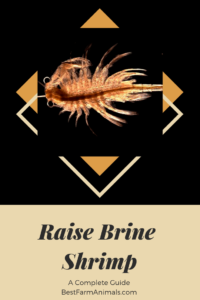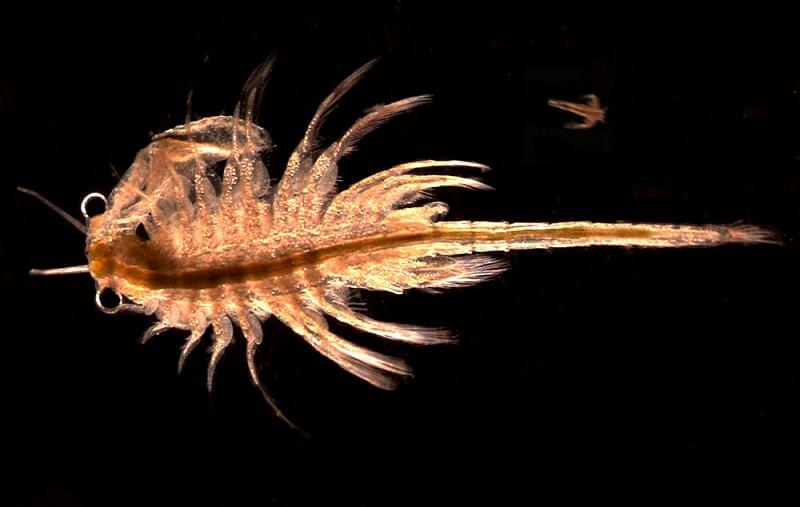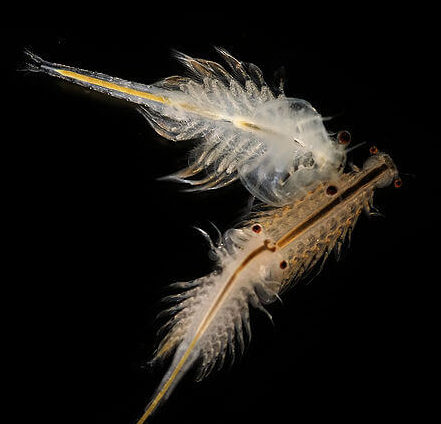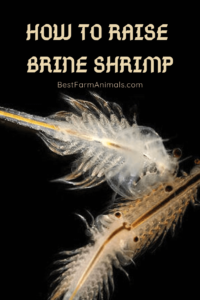Are you considering raising brine shrimp to feed your tropical fish? Brine shrimp are small and high in protein. They are a healthy food source for tropical fish. Also called artemia, they grow fast and reproduce quickly. Because they are so small, they die easily. But brine shrimp are actually fairly easy to raise if you make sure to a few vital things. Let’s take a look!
1. Gather The Right Equipment For Brine Shrimp
Brine shrimp need an ideal environment to thrive. You will need at least two containers for your brine shrimp. You can use aquariums if you already have some extra ones on hand, but aquariums aren’t necessary. Brine shrimp aren’t picky. You can use an empty 2-liter soda bottle works for hatching the shrimp. Combine it with a 5-gallon bucket for growing your shrimp. The larger tank is called a culture talk.
Both of these options are fairly cheap and will make it easy to move and transport the shrimp.
You will also need a filter and airflow. Brine shrimp are small and can easily get sucked into regular fish filters. So, it’s important to use a sponge filter. This will keep the brine shrimp safe. The sponge filter should have a hookup to an air pump. Artemia needs air and circulating water to grow well and be healthy. They also need warm water. Brine shrimp are cold-blooded so their metabolism slows down when the water is cold and speeds up when the water is warm. A heat lamp is an easy way to do this. You can also use other aquarium heaters to keep the water warm.
- 1 five-gallon bucket or Large Rubbermaid box (for the adult culture shrimp tank)
- Two-liter soda container (for the brine shrimp hatchery)
- Sponge filter
- Air pump
- Heat lamp
- Ocean salt
2. Properly Place The Shrimp Tanks
It is important to choose a good location for your brine shrimp hatchery and growth tank. The tanks should be placed in a location where the water won’t see drastic changes in temperature. Avoid placing your brine shrimp near windows, doors, or on outside walls. You should also avoid placing the aquariums in a place where the shrimp will get direct sunlight or will be blown on by your air conditioner.
You will also need an electric outlet close to where you plan to keep your shrimp.
- Avoid places with temperature fluctuations such as windows, near doors, or outside walls
- Avoid places close to an air conditioning or heating vent.
- Avoid direct sunlight
- Find a place close to an outlet.
3. Set Up Brine Shrimp Hatchery
One of the easiest ways to set up a brine shrimp hatchery is to use a 2-liter bottle. Cut the bottom off the bottle and put it upside down. Attach the sponge filter inside the bottle. Depending on the type of sponge filter you are using, you can either pull your air tubing in through the spout of the bottle or drill another hole.
This allows the sponge to filter your water and keep your baby shrimp and the eggs safe from filtration.
4. Get The Salt Level Correct For Healthy Brine Shrimp
Brine shrimp are saltwater fish. They will die in freshwater and will not do well in water that doesn’t have enough salt. It is vital to get your salt levels high enough. Your brine needs a specific gravity (sp) of 1.024-1.028. Specific gravity is the ratio of salt concentration in the water. It is also called salinity. Ideally, the salinity is 35-40 ppt.
Did you know?
Brine shrimp grow in the Great Salt Lake! That demonstrates how salty they like their water!
When setting up your hatchery, you can use any type of table salt, rock salt, or other types of salts. However, when you set up the water for your brine shrimp to grow in, the 5-gallon bucket, it is better to use ocean salt.
That’s because the ocean salt will create a more ideal environment for the brine shrimp to grow larger it. It mimics their natural habitat more closely.
5. Set The Right Acidity To Keep Shrimp Happy
Additionally, the water should be an acidity level of 7.5-8 pH. There are various commercial products available to adjust the water to be more alkaline or more acidic
Baking soda will lower the acidity of your water because it’s very alkaline. Add the baking soda in small amounts to make sure that you don’t drop the acidity of your water too much.
Sulphuric acid or peat can also be used to raise the acidity of your water to an optimal level.
Make sure to test how acidic your water is. If it isn’t in the right range, your brine shrimp won’t thrive and may even die.
6. Provide Warm Water For Hatchling Growth
Artemia love warm water. Keep your hatchery warmer to hatch eggs faster. A hatchery about 80 degrees Fahrenheit will hatch most of your brine shrimp eggs in about 24 hours. A lower temperature around 70 degrees will hatch them in about 3 days.
The water in your culture tank should be a little cooler than the hatchery. Your water should stay within a range of 65-70 degrees Fahrenheit (20-25 degrees Celsius). This can be accomplished with a heater or a heat lamp.
Placing a heat lamp above the water will help to moderate the water’s temperature. It also helps to heat the water so your brine shrimp can grow fast and well. If you are using a heat lamp instead of a tank heater, make sure that you check the temperature often until you have an idea of how far from the water the heat lamp should be kept to keep it at the right temperature.
If you use a heater, make sure to set it so that it keeps the water at the right temperature and doesn’t allow the water to cool too much or to heat too high.
7. Set Up Good Aeration
Brine shrimp need good aeration to hatch and grow. Water circulation is an absolute necessity. Make sure that you are setting up tanks that circulate the entire tank of water. If you don’t have good circulation, then you will have portions of your tank where the shrimp eggs won’t hatch.
It will also affect the overall health of your shrimp.
When you are setting up a good aeration system, make sure that it provides large bubbles to aerate the water. Brine shrimp will actually eat or swallow air bubbles if they are small. This causes problems because it the air inside of them will force them to the top of the water where they will die.
If you are using air stones, make sure that the bubbles released are large bubbles.
8. Use A Low-Level Light To Grow Quality Shrimp
Make sure that your heat lamp or other light is not too bright or close to your tank. Brine shrimp love light.
If you have a light that is too bright, it will attract your shrimp more than usual. The shrimp may use most of their energy to stay close to the light. This can detract from the growth and quality of the shrimp. Shrimp too attracted to light won’t develop as healthily because they won’t have the right swimming patterns.
You will need a brighter light for hatching. Light triggers the hatching mechanism in the eggs. An ideal level of light for hatching will be about 2000 lux of constant illumination. That’s about a 125 watt light. Instead, use a 60-100 watt bulb for growing your adult shrimp.
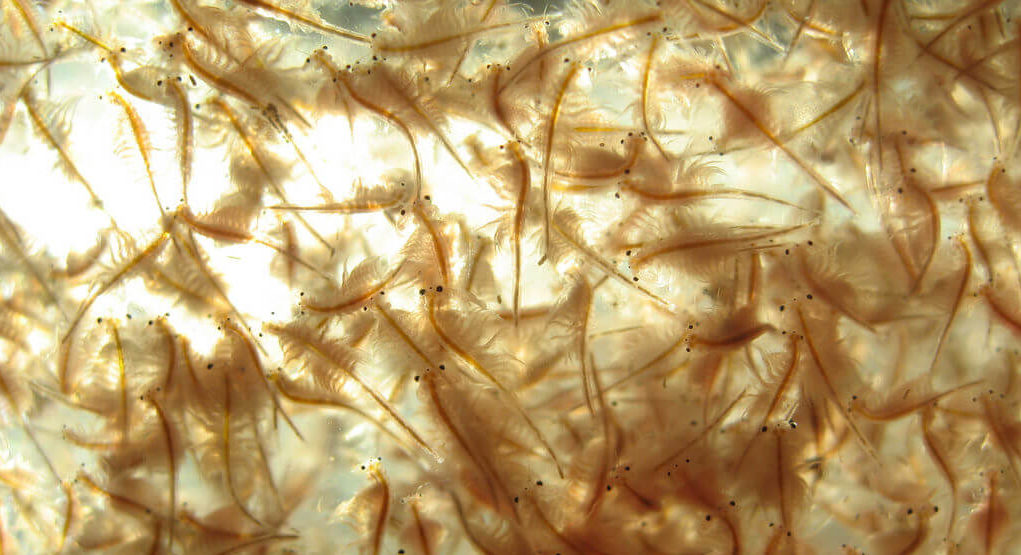
9. Correct Feeding Of Brine Shrimp
Brine shrimp love to eat but they won’t eat in the first 24 hours after hatching. Newly hatched shrimp are called nauplii. The amount of food that you need to feed them will depend on how fast you are trying to grow them and how many you are trying to grow.
Brine shrimp will eat a variety of foods. Their natural food source is the planktonic algae. They will also eat a variety of food including yeast, wheat flour, egg yolk or soybean powder. I’ve even seen brine shrimp “recipes” that call for baby food peas for brine shrimp.
But, powdered milk is not a good feeding option because it dissolves into the water and brine shrimp can’t feed on it.
For optimal growth of your brine shrimp, you should provide a constant supply of food for them to eat. This is best done by feeding the shrimp enough food to create slightly cloudy water. When the water becomes clear again, feed them again.
When you feed, there shouldn’t be so much that the food collects on the bottom of the tank. Brine shrimp must eat food that is suspended in the water. Aerating and circulating your water helps to keep the food available for the shrimp.
If you aren’t trying to grow your shrimp as quickly, or if you don’t have a lot of them, then you can feed them every 1-3 days.
You can also check the “fatness” of you shrimp to make sure they are getting enough food. Remove an eyedropper worth of shrimp from the water. Look at your brine shrimp carefully against the light and examine if their gut or bellies look full or skinny.
10. Move Adult Brine Shrimp Into The Culture Tank
Most of your brine shrimp eggs should hatch in the first 1-3 days. However, some eggs won’t hatch for even longer. Adult brine shrimp need a slightly different environment to grow healthy than the eggs need to hatch.
That’s why it’s important to have two tanks.
Once you have many shrimp that have hatched, you can move them into the larger culture tank (aka 5-gallon bucket). To do this, put a light nearer to the brine shrimp hatchery and turn off your aeration. This will allow the shrimp to swim to the top of the water.
Scoop out the top of the water from your hatchery and put it into the water in the culture tank. Make sure before you do this that the water temperature is the same so you don’t avoid harming your shrimp with drastic temperature differences. You can then allow the water to cool slightly to about 70 degrees Fahrenheit.
You can scoop out about ⅓ to half of the water in your 2-liter bottle.
Once you are done, add more water to your hatchery so that any unhatched eggs can continue to hatch and grow. Unhatched eggs will stay on the bottom of your hatchery when you turn off the air pump and wait a few minutes.
The larger tank will allow the brine more space to grow.
11. Keep The Brine Water At The Right Cleanliness
Brine shrimp actually love algae. As a result, cleaning your tanks too often or too much can impede shrimp growth. But letting the water get too filthy can also harm your shrimp. You can keep the water clean a couple of different ways, depending on how you are raising your shrimp.
If you raise your shrimp in batches of eggs and adult shrimp, then you really don’t need to clean out your tank. Brine water will last for 3 or 4 weeks while you feed your shrimp to your other fish. Simply replace the water when you start a new batch and you will be fine.
However, if you are keeping more of a continual cycle of brine shrimp going, then you will want to maintain good water quality that isn’t too clean or too dirty. Replace about 20% of the water every week. This helps to eliminate excess waste from the water.
Put the light closer to the top of your water. This will attract the brine so that you can vacuum the bottom of your tank to clean it and the waste and extra food up.
12. Catching Your Brine Shrimp To Feed Other Fish
The best way to catch your brine shrimp is with a net. Make sure that you have a net that is the right size. Different weaves on the nets will make a difference as to how small of brine shrimp you will catch.
If you need to feed small and large brine to various fish, then consider catching the small brine out of your fish hatchery. You can then use a larger net to catch brine for your bigger fish. The larger net will allow the smaller brine shrimp and eggs to fall through the net and be safe in the water.

13. Choose The Right Shrimp To Feed Your Fish
Brine shrimp change in quality as they grow. Newly hatched shrimp are high in fat. About 23% of their body weight is fat.
But, adult brine shrimp are high in protein. Adult brine have about 63% protein. This makes them a powerful protein source for fish.
The size that you should feed your fish depends on what types of food your fish need. Generally, younger fish need a diet with higher fat content. Older fish usually need a diet that is higher in protein for reproduction.
14. Feeding Brine To Freshwater Fish
Did you know?
Brine shrimp can actually survive for a few hours in freshwater! They are amazing creatures. This gives your fish time to capture and eat the brine shrimp. After catching the brine shrimp, rinse the salt off.
Then, add the brine shrimp to your fish tank.
15. Clean Equipment After Using Brine Shrimp
Cleaning your equipment is important. Salt has a great ability to wear out parts and create deposits on your parts. Additionally, you probably have algae and other bacteria growing in your brine shrimp tanks.
It is important to clean everything before you store it or start the cycle over again. This will ensure the health of your future batches of brine shrimp.
Related Questions
How Long Do Brine Shrimp Live? Brine shrimp will usually live about 3 months. However, they are a very adaptable animal. They can survive super arctic temperatures, more acidic water, and other sub-par conditions. Dormant eggs, also called cysts, can stay dormant for up to 25 years.
This provides the shrimp with the best conditions for survival. When conditions of the water are more optimal, the eggs will hatch. While brine shrimp can reach adulthood in as little as 8 days, it can also take them between 3 and 6 weeks. When the temperature, acidity, or salinity of the water is not ideal, the shrimp grow much slower.
Are Brine Shrimp And Sea Monkeys The Same?
Sea Monkeys are essentially commercially bred brine shrimp. They are not usually the same exact classification as the brine shrimp you buy to feed fish because they have been bred to be a little different. Sea Monkeys are a hybrid brine shrimp make to live a little longer and hatch a little earlier. Sea Monkeys can live as long as 2 years.
Because sea monkeys are more commercially branded, they are considered more of a novelty purchase. This makes them more expensive than regular brine shrimp eggs.
How Much Salt Should I Add For Brine Shrimp?
Brine shrimp like it very salty. They prefer a sp of 1.024 -1.028. That equates to just a little more than 1.5 Tablespoons for every liter (or quart) of water. 1.5 TBSP will equate a salinity of about 1.018. Non-iodized table salt can be used for the salt for brine shrimp.
